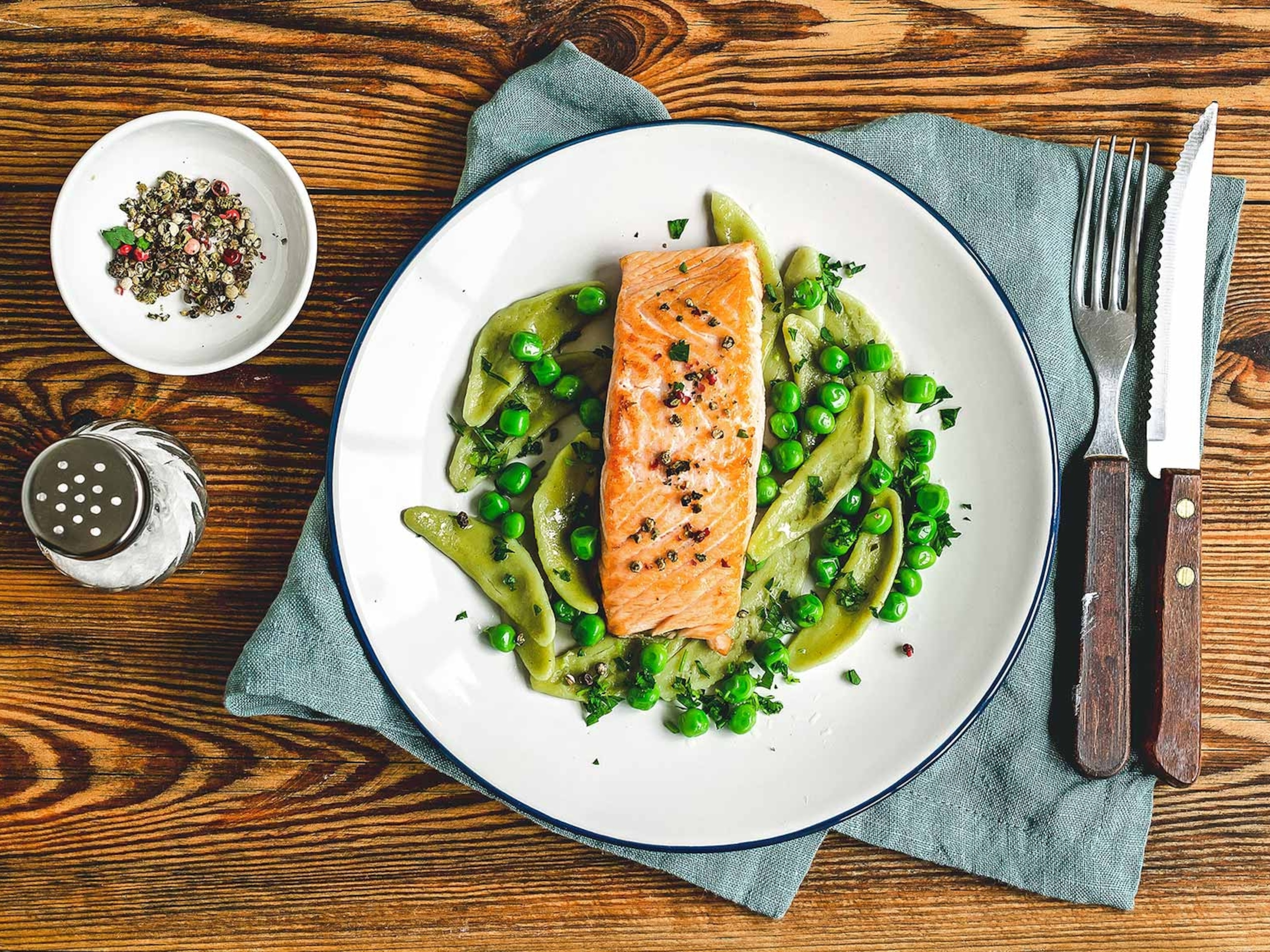
Mindful eating vs. intuitive eating: Which one is right for you?
These approaches to eating focus on listening to your body’s physical cues—and mounting evidence suggests they can improve your relationship with food and your health.
Intuitive eating. Mindful eating. When it comes to healthy eating, some of the latest hot concepts have more to do with your mind than the food that’s on the table.
Rather than focusing on weight control, the goal behind these “health-centric” eating behaviors is to promote trust in your own food choices and your body’s hunger and fullness cues. Mounting research shows that they provide a range of health benefits to both body and mind.
In an August study in the journal Appetite, researchers found that intuitive eating and mindful eating were associated with lower body mass index, better diet, and greater physical activity. They were also related to lower levels of disordered eating and depressive symptoms and improved body image and self-compassion—while intuitive eating was further associated with higher fruit and vegetable intake.
(Your detox might do more harm than good to your body.)
But what exactly are these eating habits? While they have a lot in common, they do have key differences. Intuitive eating focuses on trusting the body’s inherent cues of hunger and satisfaction to decide what, when, and how much to eat. Mindful eating asks you to slow down and bring your full attention, using all of your senses, to the act of eating. Both practices can help you learn to eat competently, which, according to world-renowned dietitian Ellyn Satter, involves being positive, comfortable, and flexible with eating enough enjoyable, nourishing food for energy and stamina.
Eating this way “can be a key step away from the pervasive diet mentality in our culture and towards a more healthful, joyous relationship with eating,” says Danielle Keenan-Miller, a clinical psychologist based in Los Angeles and author of The Binge Eating Prevention Workbook.
You don’t have to choose just one—intuitive and mindful eating work great together—but here’s what to know about the benefits of each one and how to get started.
The benefits of intuitive eating
Intuitive eating is a term that was coined by dietitians Evelyn Tribole and Elyse Resch in 1995. The practice incorporates 10 principles that encourage people to tune out external messaging from diet culture (and other people) and listen to their body’s hunger and fullness cues. This way you can eat the foods you enjoy until you feel satisfied, not stuffed, and feel good about the way you’re eating. The principles also emphasize the importance of enjoying the way your body feels when you move and to respect your body.
Interestingly, research suggests there’s a two-way street between intuitive eating and having a positive body image, particularly when it comes to appreciating your body and how it functions, among adult women. In other words, intuitive eating fuels a positive body image and vice versa.
(The Mediterranean diet has stood the test of time for a reason: It works.)
The benefits don’t stop there. A 2022 study in the American Journal of Health Promotion found that women who scored higher in measures of intuitive eating tend to have lower psychological distress, body mass index (BMI), and disordered eating patterns, compared to those with other eating styles. Over time, intuitive eating is also associated with a lower risk of developing depressive symptoms, or having self-esteem problems or body dissatisfaction, according to a study involving 1,491 participants who were followed for eight years.
“Intuitive eating offers freedom from yo-yo dieting and food rules,” says Rachel Marshall, a clinical psychologist with expertise in eating and weight concerns who is based in Greenwich, Connecticut. People “become more attuned to their body’s cues and needs, thereby building self-trust and body acceptance. This practice leads to enjoying food more and feeling less stress and anxiety about eating.”
As an added benefit, there seems to be a hand-me-down element to intuitive eating: A study in a 2024 issue of Appetite found that mothers who engage in intuitive eating are likely to have adult daughters who follow in their footsteps—and both are likely to have greater well-being than mother-daughter pairs who diet to lose weight.
The benefits of mindful eating
By contrast, mindful eating involves paying full attention to the experience of eating and the sensory qualities of the food. To do that, it’s important to eat without distractions (not in front of the TV or your phone or while you’re working). It also involves a nonjudgmental awareness of the physical and emotional sensations that accompany eating.
(Does meditation actually work? Here’s what the science says.)
The practice is associated with many health benefits. A study in March 2024 issue of the journal Cureus found that people with type 2 diabetes who engage in mindful eating have a lower BMI and lower levels of hemoglobin A1C, a measure of average blood sugar levels over three months. A study in a 2022 issue of the journal Eating and Weight Disorders found that mindful eating is associated with less emotional eating and less uncontrolled eating.
“In addition, there is a small body of evidence that suggests these practices may be associated with improvements in key health markers including lipid profiles, glucose regulation, and inflammation in the body,” says Keenan-Miller. “There is no biological downside to these approaches to eating.”
How to change the way you eat
These methods may not be suited to a DIY approach for everyone: If you have an eating disorder, it’s best to work with a psychotherapist and/or a dietitian for guidance on using these practices, experts say. After all, “somebody struggling with an eating disorder doesn’t know what full feels like,” says Rachel Goldman, a psychologist specializing in eating behavior and a clinical assistant professor of psychiatry at the NYU Grossman School of Medicine.
But for others the first step to begin eating intuitively is to ditch the idea that foods are “good” or “bad” and to “give yourself unconditional permission to eat all food without guilt,” Marshall says. “Consider how different foods make you feel physically and choose foods that satisfy your taste buds and your body’s needs.”
As you eat, tune into your body’s hunger and fullness signals, using a scale of one (very hungry) to 10 (overly full), advises Susan Albers, a clinical psychologist at the Cleveland Clinic and author of Eating Mindfully: How to End Mindless Eating and Enjoy a Balanced Relationship with Food. When you get to a point where you feel pleasantly satisfied, not stuffed, that’s a good time to stop. This idea is akin to a concept in the Okinawan diet, which is considered one of the healthiest on the planet: hara hachi bu, a practice that encourages people to stop eating when they're 80 percent full.
(Why the traditional Okinawan diet is the recipe for a long life.)
Mindful eating can also be cultivated. “Mindful eating is more about how you eat than what you eat,” Albers says. To that end, it’s important to eat slowly and chew your food thoroughly; consider putting down your fork between bites. “Pay attention to the taste, texture, aroma, and sounds of your food—this helps boost your enjoyment,” Albers says. “Recognize when you feel physically and/or emotionally satisfied”—and use that as a cue to stop eating.
It can take time, practice, and patience to change how you eat. “I find it helpful think of it as a direction rather than a goal—these are designed to be long-term practices,” says Rachel Rodgers, director of the Applied Psychology Program for Eating and Appearance Research (APPEAR) at Northeastern University in Boston.
Many people struggle with the fear that mindful and intuitive eating will lead them to overeat, Marshall says. “Interestingly, research shows the opposite to be true. Restrictive eating often leads to overeating forbidden foods. When people stop restricting food, they eat foods [they enjoy] until they are satisfied, and the drive to overeat diminishes.”
Another common stumbling block: fear of wasting food. “Many people were taught to clean their plate as children—as a result, they often eat past the point of fullness or out of obligation,” Marshall says. To overcome this, give yourself permission to stop eating when you’re satisfied and save the leftovers for later. That way, you can enjoy the meal more than once—mindfully.








